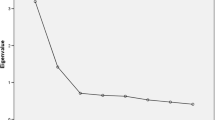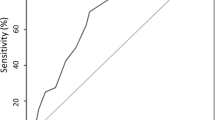Abstract
Purpose
The Epworth Sleepiness Scale (ESS) is extensively used for evaluating daytime sleepiness in patients with sleep apnea–hypopnea syndrome (SAHS). The aim of this study was to translate and validate the ESS in the Serbian language.
Methods
The Serbian version of the ESS (ESSs) was administered to 112 patients with symptoms of sleep disorder breathing referred to Sleep Center of the Institute for Pulmonary Diseases of Vojvodina, Sremska Kamenica, Serbia and 111 healthy controls. Test–retest reliability was tested in 19 healthy subjects.
Results
Patients referred to the Sleep center had significantly higher ESS scores compared to controls (9 vs. 4, p < 0.001). The difference was also present for each item separately, excluding item 5. The ESSs scores were significantly higher in patients with severe (median, 13.5; interquartile range (IQR), 10.3–17.8) compared to moderate (median, 9; IQR, 7.3–9.5; p = 0.005) and mild SAHS (median, 8; IQR, 5.5–9.7; p < 0.001). Item analysis demonstrated good internal consistency of the scale (Cronbach’s alpha 0.88 in patients and 0.72 in healthy controls). Test–retest Spearman’s correlation coefficient was 0.68 (p = 0.001).
Conclusion
The Serbian version of the ESS demonstrated good internal consistency and test–retest reliability. The ESSs could be used for both clinical practice and research in Serbian population.

Similar content being viewed by others
References
Johns MW (1991) A new method for measuring daytime sleepiness: the Epworth sleepiness scale. Sleep 14:540–545
Johns MW (1993) Daytime sleepiness, snoring, and obstructive sleep apnea. The Epworth Sleepiness Scale. Chest 103:30–36
Johns MW (1992) Reliability and factor analysis of the Epworth Sleepiness Scale. Sleep 15:376–381
Hardinge FM, Pitson DJ, Stradling JR (1995) Use of the Epworth Sleepiness Scale to demonstrate response to treatment with nasal continuous positive airways pressure in patients with obstructive sleep apnoea. Respir Med 89:617–620
Pouliot Z, Peters M, Neufeld H, Kryger MH (1997) Using self-reported questionnaire data to prioritize OSA patients for polysomnography. Sleep 20:232–236
Teran-Santos J, Jimenez-Gomez A, Cordero-Guevara J, Cooperative Group Burgos-Santander (1999) The association between sleep apnea and the risk of traffic accidents. N Engl J Med 340:847–851
(1999) Sleep-related breathing disorders in adults: recommendations for syndrome definition and measurement techniques in clinical research. The Report of an American Academy of Sleep Medicine Task Force. Sleep 22:667–689
Bloch KE, Schoch OD, Zhang JN, Russi EW (1999) German version of the Epworth Sleepiness Scale. Respiration 66:440–447
Tsara V, Serasli E, Amfilochiou A, Constantinidis T, Christaki P (2004) Greek version of the Epworth Sleepiness Scale. Sleep Breath 8:91–95
Takegami M, Suzukamo Y, Wakita T, Noguchi H, Chin K, Kadotani H, Inoue Y, Oka Y, Nakamura T, Green J, Johns MW, Fukuhara S (2009) Development of a Japanese version of the Epworth Sleepiness Scale (JESS) based on item response theory. Sleep Med 10:556–565
Izci B, Ardic S, Firat H, Sahin A, Altinors M, Karacan I (2008) Reliability and validity studies of the Turkish version of the Epworth Sleepiness Scale. Sleep Breath 12:161–168
Bertolazi AN, Fagondes SC, Hoff LS, Pedro VD, Menna Barreto SS, Johns MW (2009) Portuguese-language version of the Epworth sleepiness scale: validation for use in Brazil. J Bras Pneumol 35:877–883
Cho YW, Lee JH, Son HK, Lee SH, Shin C, Johns MW (2010) The reliability and validity of the Korean version of the Epworth sleepiness scale. Sleep Breath (in press)
Izquierdo-Vicario Y, Ramos-Platon MJ, Conesa-Peraleja D, Lozano-Parra AB, Espinar-Sierra J (1997) Epworth Sleepiness Scale in a sample of the Spanish population. Sleep 20:676–677
Chen NH, Johns MW, Li HY, Chu CC, Liang SC, Shu YH, Chuang ML, Wang PC (2002) Validation of a Chinese version of the Epworth sleepiness scale. Qual Life Res 11:817–821
Young T, Palta M, Dempsey J, Skatrud J, Weber S, Badr S (1993) The occurrence of sleep-disordered breathing among middle-aged adults. N Engl J Med 328:1230–1235
Bonnet MH (1985) Effect of sleep disruption on sleep, performance, and mood. Sleep 8:11–19
Castronovo V, Canessa N, Strambi LF, Aloia MS, Consonni M, Marelli S, Iadanza A, Bruschi A, Falini A, Cappa SF (2009) Brain activation changes before and after PAP treatment in obstructive sleep apnea. Sleep 32:1161–1172
Neuberger HR, Bohm M, Mewis C (2006) Sleep apnea and heart disease. N Engl J Med 354:1086–1089, author reply 1086–1089
Yaggi HK, Concato J, Kernan WN, Lichtman JH, Brass LM, Mohsenin V (2005) Obstructive sleep apnea as a risk factor for stroke and death. N Engl J Med 353:2034–2041
Strohl KP (1996) Diabetes and sleep apnea. Sleep 19:S225–S228
Stoohs RA, Guilleminault C, Itoi A, Dement WC (1994) Traffic accidents in commercial long-haul truck drivers: the influence of sleep-disordered breathing and obesity. Sleep 17:619–623
Breslau N, Roth T, Rosenthal L, Andreski P (1997) Daytime sleepiness: an epidemiological study of young adults. Am J Public Health 87:1649–1653
Hayes AL, Spilsbury JC, Patel SR (2009) The Epworth score in African American populations. J Clin Sleep Med 5:344–348
Acknowledgments
MK and IK designed the research and drafted the manuscript. SP, MD, and MI collected the data. MK and IK analyzed the data, and NT and VK revised the manuscript.
Declaration of interest
The authors declare that they have no conflict of interest.
Author information
Authors and Affiliations
Corresponding author
Appendix
Appendix

Rights and permissions
About this article
Cite this article
Kopitovic, I., Trajanovic, N., Prodic, S. et al. The Serbian version of the Epworth Sleepiness Scale. Sleep Breath 15, 775–780 (2011). https://doi.org/10.1007/s11325-010-0435-3
Received:
Revised:
Accepted:
Published:
Issue Date:
DOI: https://doi.org/10.1007/s11325-010-0435-3




